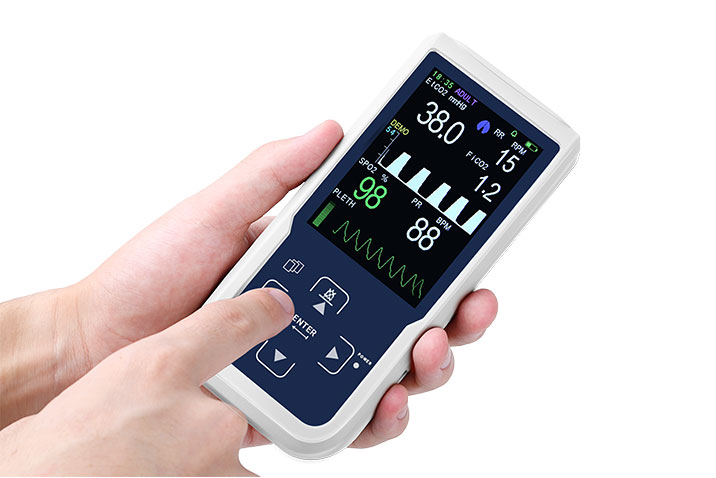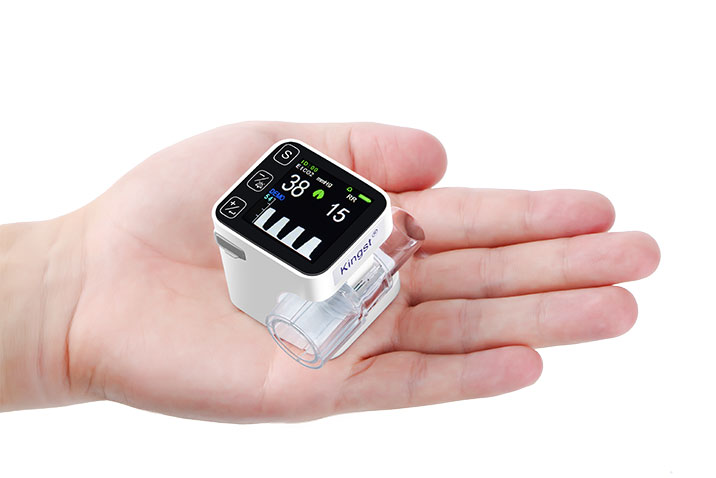The capnography monitor is a medical device specifically designed to measure the patient's ETCO2 (ETCO2) level. It provides important information on the patient's respiratory function and ventilation status by analyzing exhaled carbon dioxide. The device has multiple functions such as real-time monitoring, precise sensing, high and low alarms, data storage and transmission, and can play a key role in anesthesia management, intensive care, emergency first aid, and postoperative recovery.
One of the features of the capnography monitor is the real-time monitoring function. The device can continuously record the patient's ETCO2 level and help medical staff quickly understand the patient's respiratory status. This is especially important for emergency first aid scenarios, because obtaining accurate respiratory data in a timely manner can greatly improve the success rate of rescue. In addition, the application of precision sensors ensures the accuracy of measurement data, which is of great significance for postoperative recovery and patient management in intensive care. The high and low alarm function can send out an alarm in time when the carbon dioxide level is abnormal, reminding medical staff to take necessary measures.
Data storage and transmission is another important feature of the capnography monitor. The device can store large amounts of monitoring data and share data with other medical equipment and systems through wireless transmission or wired connections. This not only facilitates long-term patient monitoring and data analysis, but also provides technical support for telemedicine.
In terms of applications, capnography is widely used in anesthesia management. During the anesthesia process, the patient's respiratory function is suppressed. Monitoring the ETCO2 level can help the anesthesiologist adjust the depth of anesthesia in a timely manner and avoid the risks caused by excessive or insufficient anesthesia. In intensive care, equipment can be used to monitor the respiratory status of critically ill patients and help medical staff detect serious problems such as respiratory failure in time. In emergency first aid scenarios, ETCO2 monitors also play an irreplaceable role, providing important basis for rescue work by monitoring the patient's breathing in real time. During the postoperative recovery period, monitoring ETCO2 levels can help detect potential respiratory complications and ensure patient safety.
The portable design of the capnography monitor makes it widely used in a variety of situations. The device is small, lightweight and easy to carry, especially suitable for emergency and emergency use. Its all-solid-state design and fast warm-up feature allow it to perform well in a variety of environments, and it provides an intuitive data display interface for easy operation and data reading.
The palm-type capnography monitor is a very portable device, suitable for use in emergency and outdoor emergency situations where rapid response is required. Its compact design and light weight make it easy to carry around and can complete preheating and start monitoring in a short time. The intuitive data display interface of the palm monitor allows medical staff to quickly obtain the patient's respiratory data and respond in a timely manner.

Handheld capnography monitors are widely used in medical environments such as emergency departments and ICUs due to their lightweight design, instant feedback and durability. The handheld device not only provides instant capnography waveforms and data, but can also be connected to the ventilator to provide more comprehensive patient monitoring.

In terms of anesthesia management, the application of capnography is particularly important. The anesthesiologist can adjust the anesthesia dose by monitoring carbon dioxide levels to ensure the patient maintains stable breathing throughout the procedure. The real-time display of capnography waveform can help anesthesiologists more accurately judge the patient's ventilation status and avoid breathing problems caused by too deep or insufficient anesthesia. Handheld devices are more flexible in anesthesia management and can monitor patients anytime and anywhere, providing instant feedback.
In the intensive care unit (ICU), capnography is an indispensable monitoring tool. Severely ill patients usually require close monitoring of their respiratory and circulatory functions, and ETCO2 levels are an important indicator for evaluating ventilation effectiveness and respiratory function. Through continuous monitoring, medical staff can detect and deal with serious problems such as respiratory failure and pulmonary embolism in time, improving the survival rate of patients. Handheld devices also play an important role in the ICU. Their portability and high performance enable them to provide continuous monitoring during patient transportation, ensuring that patients receive comprehensive monitoring at all stages.
Emergency first aid is another important application scenario of capnography monitor. In emergency emergencies, patients' conditions change rapidly and their respiratory status is unstable. Timely monitoring of ETCO2 levels is crucial to determine the patient's respiratory function and ventilation status. With its portability and rapid response capabilities, the palm monitor can be quickly deployed on site to provide accurate respiratory monitoring data and provide scientific basis for rescue work. In medical environments such as emergency departments and ICUs, Capno-T serves as an important monitoring tool that can help medical staff comprehensively assess and manage patients' respiratory conditions. Its instant feedback function can quickly display monitoring results and issue alarms, helping medical staff make timely decisions and improve first aid efficiency and success rate.
In addition, the application of capnography monitor in postoperative recovery cannot be ignored. Postoperative patients are prone to respiratory complications, especially if they receive general anesthesia. By continuously monitoring ETCO2 levels, medical staff can detect abnormalities in time, adjust treatment plans, and ensure safe recovery for patients. The flexible application of palm-type and handheld devices in postoperative monitoring enables medical staff to monitor patients anytime and anywhere and provide personalized care.
In emergency situations, the portability and durability of capnography monitors are particularly important. In field first aid and emergency situations, the environment is complex and changeable, and the requirements for equipment are higher. Portable monitors such as Capno-T can provide stable monitoring services in harsh environments with their compact, lightweight, rugged and durable design. Its rapid warm-up and instant display functions enable it to be put into use in a short time and provide reliable ETCO2 monitoring support for emergency medical teams. By obtaining the patient's respiratory data in real time, medical staff can promptly judge the patient's respiratory function and ventilation status, take effective first aid measures, and improve the success rate of rescue.
Capnography plays an important role in modern medical care. Whether it is emergency first aid, intensive care, anesthesia management or postoperative recovery, capnography monitors can provide key respiratory monitoring data to help medical staff better understand the patient's respiratory function and ventilation status. With their portability, real-time monitoring and high durability, palm-sized and handheld devices provide comprehensive solutions for a variety of medical scenarios, greatly improving the efficiency and accuracy of medical work.
